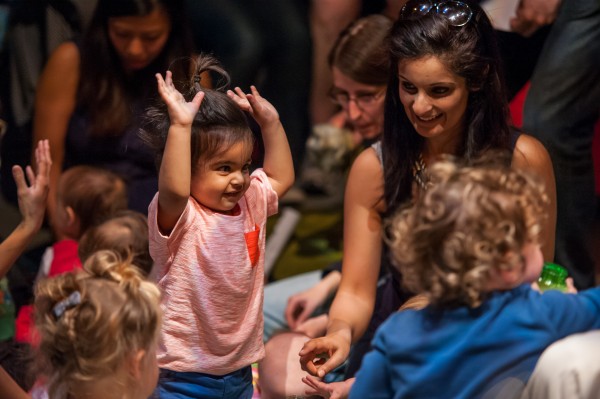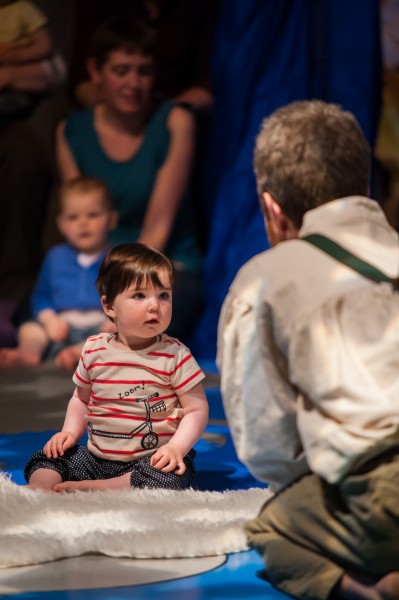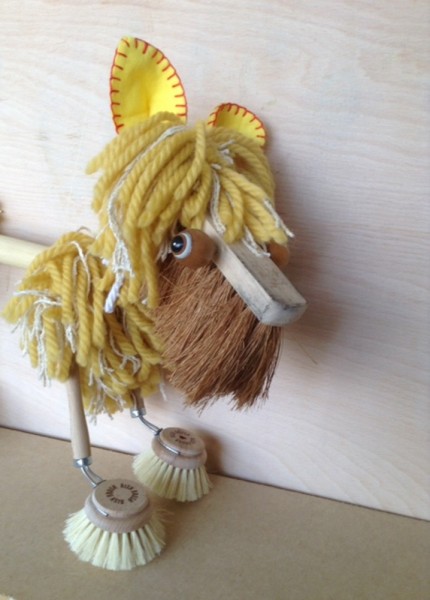I had a real treat in being invited to see Spitalfields Music's Musical Rumpus: Catch a Sea Star last week. The visit took me to a newly built community centre in the east end of London, where Spitalfields has committed to realising its vision of outreach to families living in deprived areas. The audience was made up of just such families, including young mothers, child-carers and even one very brave Dad.
This Dad’s daughter stole the show as she innocently danced around and around the set, responding with her whole body to the music she was hearing. She had a joyful smile on her face for the entire show and was completely unabashed and uninhibited by the opera singers on stage, who interweaved themselves in and around her wonderful dance moves. Once her Dad had been reassured by a nod and a smile from the Spitalfield's Learning & Participation manager, Chloe Shrimpton - sitting on stage in costume to help interpret, encourage, protect, and guide the more interactive children - he visibly relaxed. He not only allowed his daughter to express herself without worrying about the distraction, but lovingly praised and encouraged her every time she returned for his reassurance.
Parents who had previously been wondering what insanity had compelled them to bring their young tearaways to an opera production also then relaxed. One by one, they found a more comfortable position on the floor than the one they adopted at the start where they were ready to pounce, catch and drag-back their little ones off the set which had been laid out so enticingly close to their child’s eye line. And deliberately so, for this is opera for babies with a difference.
Babies and toddlers are very much welcomed to be part and parcel of the performance experience. Spitalfields Music has been committed to growing its offer for early years audiences over the last four years, despite this being one of the most expensive artforms with which to reach out to families. And yet, one of the most accessible.
Communicating with our youngest children in song transcends the boundaries of race, culture, language, and social inhibitions. It speaks to the heart of where our language first began – in the first trimester of pregnancy when our aural capacity started to develop enough to be able to hear the sing-song sounds of our mother’s voices. Then, at some point in the second and third trimesters, our brain’s emotional centre matured enough to connect those sounds to a feeling of warmth and care in its purest form, completely secure and protected from anything and everything. No wonder new-born babes crave the soothing tones of their mother’s voice, combined with their loving touch, to feel completely at peace. It’s amazing to think that whilst we were still in our mother’s womb, we were developing a penchant for singing!
Anyone who has heard opera singing will know that this can be such an intensely rich and sensory experience that resonates both physically and emotionally through our whole bodies and minds. It’s a bit like having an emotional jacuzzi! Put that in the context of a small community centre where the volume of the opera singer is magnified several times, and you’ll understand why young children simply cannot help but respond with all the expressive languages they have in their bodies and voices.
So it’s refreshingly wonderful to see the Spitalfields performers and production team embracing this with such genuine understanding and enthusiastic passion. A passion which, I might add, does not detract one bit from the artistic integrity of the piece. Whilst I have never heard Bach being played out to a narrative about a loveable dog (humorously referred to in the programme as ‘Bach meets Bark’) and a sea king who helps his urchins (the babies) to search for sea stars; the ebb and flow of the story perfectly matched the joyful and witty tone of the score.
As well as choosing a narrative that empathised with Bach’s style, the thoughtfulness of creating characters and activities that had an affinity with younger children’s interests (stroking and cuddling the dog; hiding and seeking for the star; tactile exploration with textured fabrics; continual kinaesthetic movement and even some water-play), was what made the show so engaging. Some arts companies talk about finding very young children hard to engage. On the contrary – these hugely intelligent and purposeful beings are easy to engage when you take the time to become tuned in to their interests and give them the trust, space and time to initiate and build on those interests. All children are doing is trying to make sense of the world by making connections. If an arts experience helps them to do this, their engagement, focus and concentration will last a surprisingly long time. Indeed, this performance held the attention of a 6-month old for a straight 45 minutes without caring once about food or sleep. I would say that’s a pretty good sign of Spitalfields having got it about right for that child.
Spitalfields has shown tremendous ‘in-tune-ness’ with their younger audiences and it’s a joy to see them progress their productions in this direction (I blogged about their developmental approach to early years in their last Musical Rumpus show here). Alongside this comes a highly creative team who are becoming more and more entrepreneurial in a bid to enable their early years programme to become financially independent, in order to be sustainable for a very long time to come. That kind of thinking will take them a very long way indeed.
I had the privilege of speaking to Musical Director, Sam Glazer, after the show and I asked him about the concept behind Musical Rumpus and how it came about.
SG: ‘Spitalfields Music commissioned the Musical Rumpus series as part of their early years strand, which they have beendeveloping for a few years now. Spitalfields are an organisation of values, where musical creativity is valued very strongly and the idea of the Musical Rumpus series was a way of taking that concept of early years andbringing it together with some of the core repertoire of festivals. Spitalfields Music commissions a lot of new music but it also avails itself of early music and early opera so it’s kind of a way of working out how to present that repertoire so that it is completely accessible to early years.’
RCD: ‘I noticed that although this show is taken from some of Bach’s repertoire, you have introduced the idea of Bach as Bark, as in a dog. Was there a dog in Bach originally or was that a bit of artistic licence?’
SG: ‘Yes, it was a bit of artistic licence. A lot of Bach’s music was quite serious music written for church, but he also wrote some secular cantatas which were basically little musical stories. When we were choosing the repertoire we were trying to find music which was playful and varied emotionally but had a kind of dramatic element. Bach didn’t write any operas whereas the other composers of the likes of Handel and Monteverdi were writing operatic music with inherent drama in them, so we had to be really careful in selecting the right music and his secular cantatas were perfect for that kind of playful quality.’
RCD: ‘Great! And how did you come up with the narrative to set to the music?’
SG: ‘Well, my role on the production has been to choose the music and make the musical arrangements. I work in partnership with Zoe Palmer, who wrote and directed the libretto narrative. This was our fourth show we have worked together on in this series and we have kind of experimented slightly with different ways of working. Previously we would select a long list of repertoire that we thought would work well (because there are certain limitations that won’t work). Zoe would listen to the suggested pieces and then create a narrative based on the chosen music. But this year we have done it slightly differently. I chose the music and put the content into an order based on a kind of dramatic structure, making sure the soprano and baritone arias were spread out evenly throughout the piece. In this way, we captured the musical narrative and Zoe’s libretto narrative was based on that. It felt like quite a different kind of writing.’
RCD: ‘Well, I thought it was inspired to introduce the dog character because it is the sort of animal that very young children recognise. A lot of families have dogs, they see them at home or in the park and those are the types of animals that children consider to be very friendly, something that they can care for, and so on. It was a great way to explore their emotional development through the piece, by inviting them to interact with the dog so much. I thought it was a stroke of genius putting that type of animal in opposed to any other animal you could have chosen.’
SG: ‘And having the dog as a puppet as well I think is lovely because I think children of this age believe at the drop of a hat that it’s a real animal. It’s also good because, perhaps for some children the presence of an opera singer in close proximity could be a bit threatening at first but actually the puppet creates a bridge.’
RCD: ‘Yes, that’s a good point actually, because I did notice that the children seemed surprisingly unfazed by the pitch and the volume of the singing as well as the music in the show, despite having period instruments which are very rich and quite loud in that space. What was your thinking behind setting this show just for 0-2 ½ year olds and their parents or carers as I would have thought it would be a superb show for slightly older children as well?’
SG: ‘Inevitably it’s a little porous because some families have to bring older siblings but we feel that what we can offer that’s really special is something that is designed for the very youngest children. It’s not that the show is inappropriate for older children but, if we play to 3 and 4 year olds who are much more physically confident and more vocal, then the interaction (which is a big part of the show) changes and you don’t have the space free for slightly less confident babies to crawl through and respond to the music. So it’s really thinking about the approach that best meets the youngest one’s needs.’
RCD: ‘Yes, that makes a lot of sense. So what was the thinking behind the decision to include more words and narrative in this one than in previous Musical Rumpus shows? You would naturally think of under 2½s responding to more sensory experiences, if you like, and less word based.’
SG: ‘It’s about making an offering for the parents as well. I don’t feel that the children that we work with have any intrinsic obstacles getting in the way of their enjoyment of the music. But, quite often, their parents have a lot of anxiety about not letting their children run around or make a noise and we are very relaxed about that. We want to help the parents feel relaxed because that then leads to the children’s interaction being much better and they can play with their children in each part of the show, so the words help the parents to connect with the humour and playfulness.’
RCD: ‘Great, excellent! One of the things I love about working with early years is just being able to sit and enjoy their presence because there are so many surprising and wonderfully innocent things that the children do that just take you back to your own childhood and it’s just wonderful. What do you get as an artist working within the early years sector?’
SG: ‘Professionally it’s given me lots of new challenges in terms of arranging the musical direction, being part of the stage production, and also creating something that is just an invitation to babies and toddlers to come and play. It really a lot of fun and musically as well, it’s a real delight to just have this opportunity to play this repertoire with such fine musicians as well, it’s great!’
RCD: ‘Great – and what advice would you give to other artists looking to work with the early years?’
SG: ‘I think it’s really exciting work and you have to think on your feet, which is the whole idea behind this show. If you are working with older children in Primary or Secondary, you can more easily predict what else they will be able to do in terms of responses and participation so you can plan a little. But you can’t plan in the same way with early years children so you just have to be ready to go with whatever happens. This can be a challenge but it can also be really exhilarating and really exciting in terms of your openness to other ideas and improvisation, and makes you look differently at the interactive quality of your other work.’
RCD: ‘How wonderful, brilliant. Thanks so much, Sam, for sharing your thoughts with us, and good luck with the rest of the tour.’
Ruth Churchill Dower is the Director of Earlyarts
Spitalfields Music is at 61 Brushfield Street, London, E1 6AA
Image Credits: James Berry




